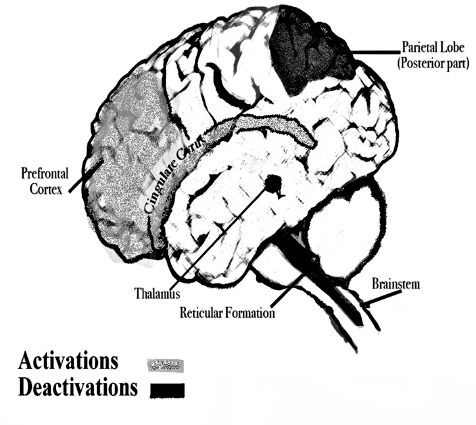

The mind of the perfect person is like a mirror. It does not lean forward or backward in its response to things.
—Chan, 1963
• Review of how stress manifests in the nervous system
• Discover how yoga and mindfulness help calm the stress pathway
• Practice bottom-up and top-down methods to shift the stress pathway back to normal
• Monitor stress mindfully with charts
According to the American Psychological Association, most mental disorders are stressful, placing extra demands on the nervous system (American Psychological Association, 2008). The response to stress is built into the nervous system in what is known as the fear/stress pathway. When functioning well, this pathway helps to alert you and protect you from threats. You can learn to manage this natural nervous system pathway and balance your responses so that the reaction works to your benefit. Yoga and mindfulness offer tangible tools known to influence the brain’s fear/stress pathway. You can learn to listen to your nervous system signals, reduce your stress response when it is overly extreme, and manage life situations better. In addition, addressing stressful situations well will have a healing influence on other problems you might want to change.
Diane was working excessively hard. She had an important position at an advertising firm that involved her traveling most weeks. Her appearance suggested authority, with her tailored suit and perfectly coiffed hair. She sat upright with crossed-legs and spoke with confidence. As an executive who was in charge of putting together ideas and presenting them to potential customers, she carried a heavy weight of responsibility. As a result, she often had to work long into the night to put the final touches on the next day’s presentation. One way she tried to alleviate her stress was by eating at expensive restaurants and shopping for designer clothes. At first, she felt justified in these indulgences, since she was working so hard. But when her expensive clothes became too tight from overindulging in food, she felt upset. She tried one extreme diet after another, sustaining a strict regime for only a few days or weeks. Her roller coaster of dieting and binging sapped her energy, and she told us, “I feel ragged! I’m losing my edge!”
We introduced Diane to yoga and mindfulness to help her rediscover her natural balance, working both bottom-up and top-down. She practiced the sun salutation (Surya Namascara) routine described in this chapter each morning before breakfast to initiate bottom-up change in her nervous system. She found that she felt calmer after she did it. In time, she was able to sustain calm longer into the day. She liked that she could perform the postures in her hotel room and that her muscles were becoming toned. She learned mindfulness, and practiced at night. As she meditated regularly, she got in touch with her deeper motivations. She realized that her love of fine clothes and gourmet food was actually an appreciation for beauty and art. We encouraged her to strengthen this higher calling (recall the niyama, ishvara pranidhana, to seek higher values). At first, she made it a practice to add a short visit to a museum or important landmark on each trip. As she exposed herself more to art, she stirred her inner art spirit. She started adding an artistic touch to her work, inspiring others with her creative presentations. Meditating regularly, practicing yoga postures, and satisfying her higher aesthetic sense, she found a healthy balance and could handle pressures without undue stress. Soon she enjoyed her work more and indulged her gourmet tastes in moderation.
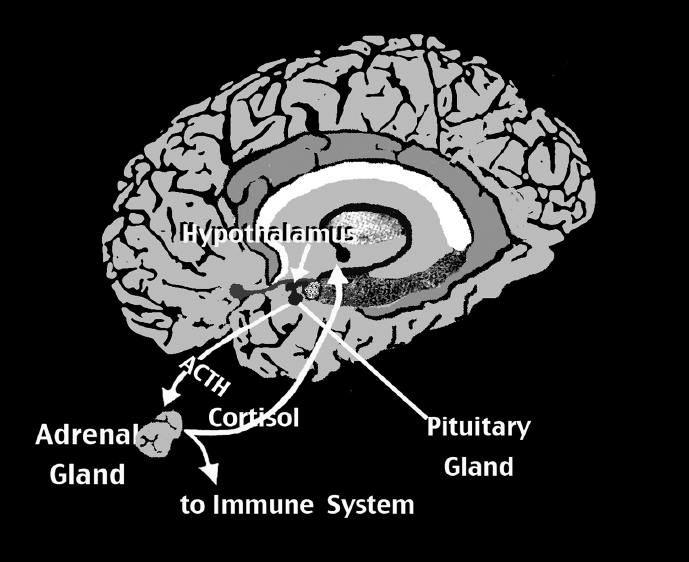
FIGURE 11.1 HPA Fear/Stress Pathway
Your nervous system has a built-in capacity to detect and respond to anything that threatens you. Here’s how it works:
• Activation of the hypothalamus-pituitary-adrenal (HPA) fear pathway
 When you face something that you perceive as a threat, your amygdala (the gateway for processing emotions) is alerted and sends a signal to the endocrine system through the hypothalamus (which regulates homeostasis and acts quickly) and to the pituitary and adrenal glands.
When you face something that you perceive as a threat, your amygdala (the gateway for processing emotions) is alerted and sends a signal to the endocrine system through the hypothalamus (which regulates homeostasis and acts quickly) and to the pituitary and adrenal glands.
 This group of organs function together.
This group of organs function together.
• Hormones and neurotransmitters involved
 This fear pathway regulates how your body responds to a threat by modulating the secretion of hormones and neurotransmitters that help to keep your body in balance. Corticotrophin-releasing hormone from the hypothalamus (CRH) signals the adrenocorticotropic hormone from the pituitary (ACTH) and cortisol from the adrenal glands, which in turn signal for activation. The heart rate increases and palms sweat, while breathing rate increases and becomes shallower.
This fear pathway regulates how your body responds to a threat by modulating the secretion of hormones and neurotransmitters that help to keep your body in balance. Corticotrophin-releasing hormone from the hypothalamus (CRH) signals the adrenocorticotropic hormone from the pituitary (ACTH) and cortisol from the adrenal glands, which in turn signal for activation. The heart rate increases and palms sweat, while breathing rate increases and becomes shallower.
 You also have hormones and neurotransmitters that decrease the reaction when the danger has passed or the balance of hormones has been lost. Glucocorticoids are released and fed back into the brain, which signals the pituitary to slow down the synthesis of CRH and ACTH, reducing cortisol.
You also have hormones and neurotransmitters that decrease the reaction when the danger has passed or the balance of hormones has been lost. Glucocorticoids are released and fed back into the brain, which signals the pituitary to slow down the synthesis of CRH and ACTH, reducing cortisol.
• Autonomic nervous system involvement
 Your autonomic nervous system is well equipped to respond rapidly to traumatic, frightening, or dangerous events when it receives signals from the HPA fear pathway.
Your autonomic nervous system is well equipped to respond rapidly to traumatic, frightening, or dangerous events when it receives signals from the HPA fear pathway.
° The two branches of the autonomic nervous system work together to help you meet each situation well.
° The sympathetic nervous system activates you to take necessary action, such as making your heart pump faster.
° The parasympathetic nervous system inhibits action, such as slowing your heart rate after danger has passed.
• The fear pathway is protective
 The fear pathway protects you from danger by making it possible for you to respond quickly. This circular process of activation and deactivation is usually kept in balance with your real-life situations.
The fear pathway protects you from danger by making it possible for you to respond quickly. This circular process of activation and deactivation is usually kept in balance with your real-life situations.
• When the fear pathway remains activated
 The fear pathway is not only activated by an immediate threat but also from remembering a past threat. You might continue to sustain the reaction by remembering a past threat vividly, as if you are still in the threatening situation. This occurs because the hippocampus, where memories are stored, is closely linked to the amygdala.
The fear pathway is not only activated by an immediate threat but also from remembering a past threat. You might continue to sustain the reaction by remembering a past threat vividly, as if you are still in the threatening situation. This occurs because the hippocampus, where memories are stored, is closely linked to the amygdala.
• How the activated fear pathway becomes a stress pathway
 This normal, protective fear pathway transforms into a stress pathway by remaining activated without flowing back to a resting state. When your nervous system stays in an over-activated state, it can put a strain on your mind, brain, and body, similar to how revving your car at high rpms is hard on the engine. When you are under stress, your thinking processes become somewhat disrupted, and you feel tired and nervous. You may also have difficulty sleeping, and eat too much or too little.
This normal, protective fear pathway transforms into a stress pathway by remaining activated without flowing back to a resting state. When your nervous system stays in an over-activated state, it can put a strain on your mind, brain, and body, similar to how revving your car at high rpms is hard on the engine. When you are under stress, your thinking processes become somewhat disrupted, and you feel tired and nervous. You may also have difficulty sleeping, and eat too much or too little.
In numerous studies, yoga and mindfulness have been found to lower the activation of the nervous system and restore balance.
You may have lost awareness of your stress response, particularly if it has been sustained over a long period. You can, however, learn to recognize some of the signs of your stress pattern that occur when your stress pathway remains activated. Use the stress symptom checklists here to track the changes that occur in your body, emotions, and behavior. Check off the typical symptoms that you notice when you are stressed. Then you can anticipate the onset. When you observe that you have entered your stress pattern, practice the exercises in this chapter to help shift to a healthier balance.
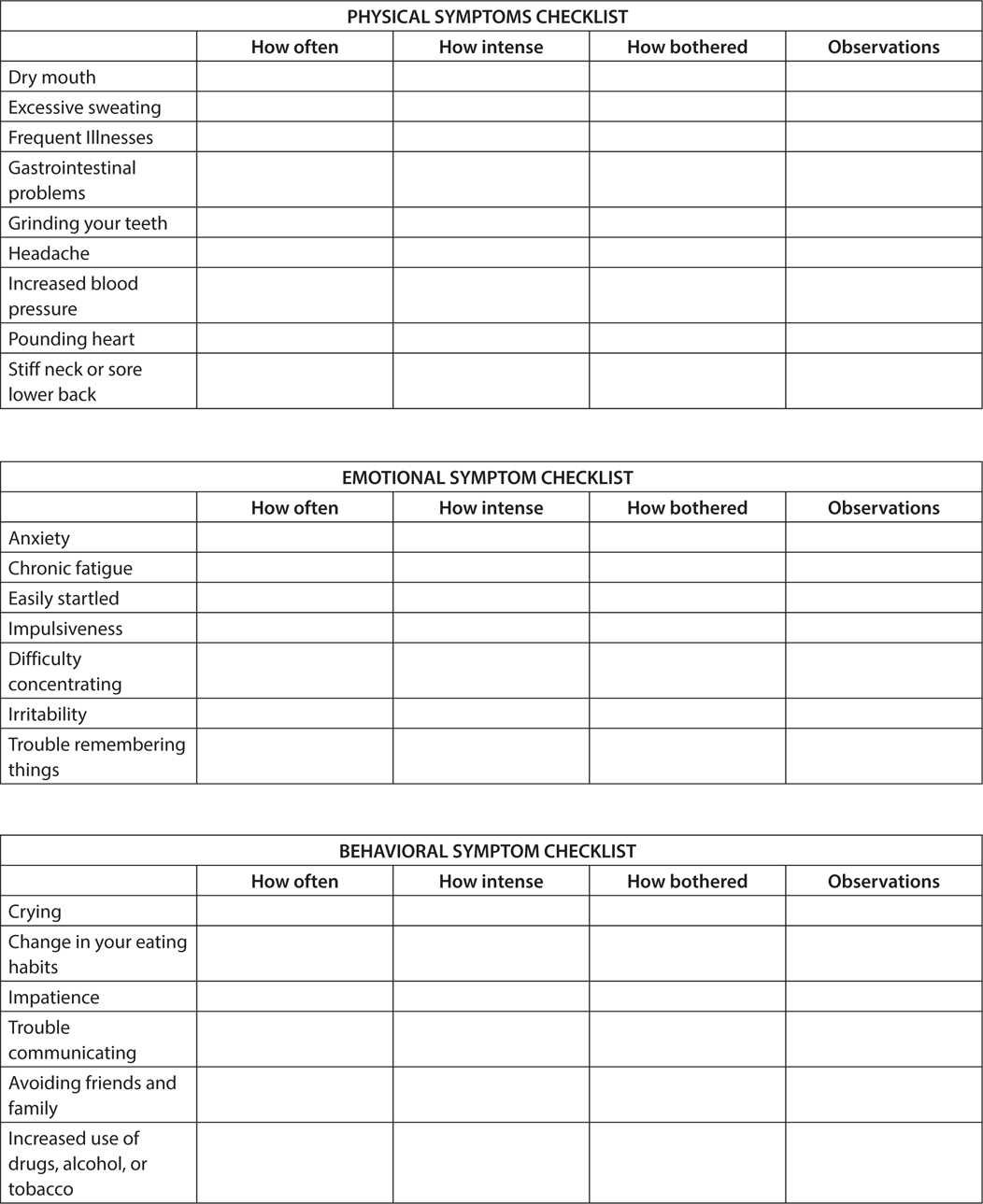
FIGURE 11.2 Chart Your Stress Reaction
You can calm your nervous system bottom up, by rebalancing and calming your body. You can also think about the stressors that you face, influencing the reaction top down. We have found that working on stress both top down and bottom up has a more powerful effect. The exercises that follow offer bottom-up and top-down processing methods to help you calm a chronically over-activated stress pathway and find a balance that will help you meet your demands optimally.
Bottom-up change can be initiated through a variety of postures and breathing exercises. When initiating a change to your nervous system, allow some time to feel the effects. Make these exercises a regular part of your routine, and you will eventually sustain deeper calm and comfort.
The sun gives its energy to the world, and similarly, the sun salutation is believed to energize the entire body. The dynamic, balanced movements reach from head to toe, with forward and backward bending movements. Breathing is combined with the movements to help you develop control and be calm. This series can help you lose weight, massage your digestive system, and regulate circulation. Regular practice will lead to feelings of well-being.
TIP: Keep your mind focused on your movements and your breathing. Relax any unnecessarily tense areas to allow your body to move gently back and forth, without forcing a movement to a position farther than is comfortable. Don’t make yourself take deep breaths, just breathe comfortably as you move. Be patient and persistent for the best results. With breath and movement united, you will free the flow of energy to help you find calm and balance.
The sun salutation is performed in slow, continuous motion. You can repeat the entire series several times, up to ten times each day, but two to three times is usual, especially if you do it daily.
Breathing should be coordinated with each move in the following way: Breathe in when you stretch back or arch. Breathe out when you bend forward or contract inward. Make your breaths and your movements slow and continuous. As you learn to pay attention to what you are doing and synchronize your breathing with your movements, you will experience a union of mind and body that can be uplifting. Allow yourself to enjoy this experience.
Before you begin, warm up for several minutes with a few gentle stretches and arm swings, and by raising and lowering your legs. Once your body feels limbered and relaxed, begin performing the sun salutation.
1. Opening Position: Stand straight in the mountain pose, with your feet together, chest lifted, shoulders square, and neck lengthened. Bend your elbows and hold the palms of your hands together, thumbs touching, at the center of your chest. Keep your weight evenly distributed between your two feet. Close your eyes and breathe in and out several times, centering yourself in your body experience as you stand quietly.
2. Upright Arch Open your eyes and inhale as you stretch your arms up over your head, palms facing each other. Arch back as you push your hips out, keeping your legs straight. Gently relax your neck back. Begin to arch from your upper back rather than the lower back. Arch slowly and carefully.
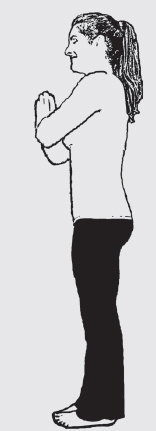
FIGURE 11.3 Sun Salutation Opener

FIGURE 11.4 Upward Arch
3. Forward Bend: Exhale as you slowly bend forward, keeping your arms extended. Move your arms and upper body downward, bending at the waist, toward the floor. Keep your back straight for as long as possible as you go down. Let your neck relax and your head hang down. Bring your fingertips down to your toes and bend your knees slightly if needed. Hold briefly as you relax fully into the forward stretch.
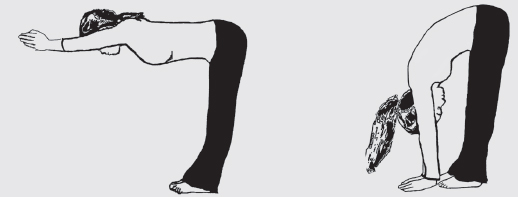
FIGURE 11.5a Forward Bend A and 11.5b Forward Bend B
4. Lunging Arch: Inhale as you extend your left leg back approximately four feet behind your right, allowing your left knee to rest on the floor. Your right foot rests flat on the floor with your knee bent. Let your hands rest on the floor at your sides to steady this motion. Then, raise your arms up overhead, arch your back and look up toward the sun. If you feel unstable in your balance, keep your hands on the floor at your sides as you arch. Hold briefly, allowing your upper body to stretch backward as much as is comfortable.
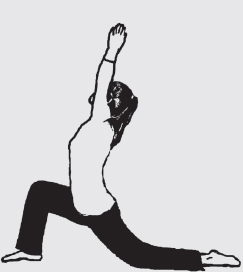
FIGURE 11.6 Lunge
5. Dog Pose: Exhaling, bring your left foot back next to the right and perform the dog pose. Lift your hips up as high as you can as you place your hands, palms down on the floor extended out in front of you. Expand your chest as you relax your neck and look down between your hands. Push your heels toward the floor, allowing a gentle stretch.
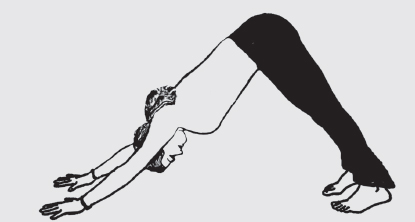
FIGURE 11.7 Downward Dog
6. Cobra Stretch: Lower yourself face down to the floor and inhale as you perform the cobra pose, arching and drawing your upper body slowly up, vertebrae by vertebrae, beginning at your lower back and moving upward. As you get to the neck area, allow your head to arch back slowly until you achieve a full upper body stretch.
7. Now you are halfway through the series of movements. The second half of the sun salutation involves repeating all the same motions on the opposite side. (if you began with your right leg forward and your left leg extended back, now bring your left foot forward and extend your right leg back.) Following the cobra pose, perform the dog pose as you exhale. Then lunge back with your right leg as you inhale and smoothly arch back with your upper body. Exhale as you bring your right leg back to your left and lift your hips up as you bend your upper body down, bringing your head toward your knees. Straighten your upper body up and lift your arms overhead to stretch backward as you inhale. End as you began, with your arms returning to the position at your chest, palms and thumbs touching. Pause, close your eyes, and pay attention to your feelings as you sense the effects of the sun salutation. Meditate for a moment in this position, and then begin again.
The breath is a direct link to the emotions and the nervous system, so it can be used as a resource for calming. This classic breathing exercise helps to gently soften each breath, thereby setting in motion a calmer mind and body. Perform this exercise at different times throughout the day and evening when in the midst of stress to offer yourself an oasis of relaxation and calm. Your nervous system eventually responds naturally with a shift to a more comfortable balance.
Sit comfortably with your legs crossed on a pillow on the floor. Or, if you prefer a chair, sit in an upright chair letting your feet rest flat on the floor. In either position, keep your back relatively straight so that your breathing passages are unobstructed. Take a few minutes to focus on breathing, either listening to your breath or counting the breaths as described in Chapter 5. When your attention is fairly well focused on breathing, soften your breath. Draw air in gently and smoothly, not too fast or too slow, and then let it softly and smoothly out. There is no need to force or hold your breath. Instead, just breathe gently and comfortably. Your breathing will be natural and light, but slightly slower. Keep your attention focused on your breathing and sustain this for several minutes, working up to 10 to 15 minutes.
Taking time to deliberately relax is a helpful component of a stress-reducing regimen. We encourage you to take a periodic break to lie down either in savasana (on your back) or crocodile (on your belly). Refer to the instructions for “Prone Pose, Savasana” and “Crocodile Pose, Makarasana” in Chapter 6, pages 56-57, for the position. As you lie comfortably, allow your breathing to be soft and steady. Notice the surface you are lying on and how your body meets this surface. If you notice you are holding your body away from the surface, try to let go as if sinking into it or floating lightly over it. You may notice tension in your neck, back, shoulders, or perhaps arms or legs. If so, can you allow these muscles to relax?
Pratyahara is the discipline of withdrawing your senses from the outer world. See Chapter 7 for additional pratyahara exercises. You can use any of these exercises to take a short vacation from a stressful situation, allowing your nervous system an opportunity to rest and restore. Practice this meditation often, for short periods—even one minute will do—and you might find that you can handle stress more easily and comfortably.
Lie down in the savasana pose. Withdraw your attention from your outer surroundings as much as possible. Do not, for example, listen to the sounds of traffic outside. Instead, turn your attention inward. Begin by turning your attention to your muscles. Notice where they feel tense and where they feel relaxed. If you are able, let go of any tensions that you might not need. Breathe comfortably and allow any relaxation that can occur. Now, try to relax your thoughts just as you relax your body. Without forcing thoughts to relax, simply let any irrelevant thoughts go and stay with this peaceful, relaxed moment. If you find yourself thinking about your stressful situation, remind yourself that right now you are turning inward rather than outward. And in this quiet moment, there doesn’t need to be stress, since you are resting quietly. Bring your attention back to your muscles, your breathing, and the calm moment now. You do not need to think about anything outside, just your own inner calm as it develops now. If you notice your thoughts wandering, gently bring them back to this calm moment as soon as you can. Continue focusing inwardly. Start with a very short time, especially if you feel pressured. Sustain this meditation for longer periods as you develop more skill, allowing periods of relief for your mind, brain, and body.
Mindfulness has a dual effect of calming the lower areas in the brainstem while simultaneously activating the attentional areas of your prefrontal cortex. Practice mindfulness meditation daily. Use the methods in Chapter 10, beginning with mindfulness of body, feelings, and thoughts. Take another step back to notice the flow of experiencing as well. Do you feel bombarded with experiences? Often when people are stressed, they feel overwhelmed by an intensity of stimuli. Recall that with mindful observing, you simply notice the qualities of sensations, thoughts, and feelings, just as they are. As you follow your experience moment-by-moment, also observe how it changes throughout the meditation session. You may find that thoughts become clear, emotions steady, and sensations ease. You may also discover that you have resistance to implementing the skills, leading to defenses that turn off self-awareness. Take note of them. You can learn a lot from your resistant reactions. Make mindfulness a regular practice and you will initiate a change in your way of responding to stress.
It has become a cultural mantra to lament about the stressful pace of life. How many times have you complained about how stressed you are? But by emphasizing how bad, hard, or painful your stress is, you inadvertently make it worse! You will find a distinct benefit from altering your judgmental thinking. This series of meditations will help you to become mindfully aware of your judgments as you make them, and then guide you in changing them.
Begin by sitting comfortably and relaxing for a minute. Now, take a step back from your usual thoughts about your stress level to notice what you are telling yourself. Are you telling yourself negative things such as “I’m really stressed!” or “How awful this situation is!” or “Other people are bothering me, and shouldn’t!”? Be mindful of whatever you are thinking about. You may find it easier to notice by saying to yourself, “Now I am aware of thinking this; now I am thinking that. . .” But when you tell yourself how bad things are, you are making an evaluation. Each judgment, whether accurate or not, is not the stress itself. These judgments remove you from your experience in this moment and add to your discomfort. Observe the judgment within the thought. Mindfully recognizing when you are adding to your discomfort with negative judgments will lower your stress.
Now, how do you react to your judgmental assessments of yourself? Taking a moment to reflect inwardly on what you sense, feel, and think immediately after making a judgment will help you to answer this question. Perform this exercise whenever you find yourself judging something or someone.
Mindfully notice any physical sensations, emotions, or thoughts you might be having immediately following any judgments that you make. For example, if you judged that stress is awful and you can’t stand it, do you feel an evoked sensation such as tightness in a muscle, a quickening of your breathing, or a stab of anxiety? Continue in this way for several minutes, noticing your judgments and any reactions to them. If you detect a pattern of worry or anxiety during the day, look for a judgmental thought behind it. When you feel that you have become aware of your judgments and your reactions to them, move on to the next exercise.
You probably have begun to notice how your judgments elicit uncomfortable reactions. This meditation will show you how to let go of your negative thought habits so that you can open the way for something better.
Sit comfortably for a moment and allow yourself to relax. We invite you to think differently for a moment. Have you ever considered that sometimes stress may serve an important purpose? For example, higher education is worthwhile, but most students will agree that the tests and papers are stressful. People sometimes feel stressed while planning a wedding, but once it’s all finished, most people will remember the wedding experience as deeply meaningful. And there are many reports of ordinary people who act heroically during a disaster, often gaining more self-confidence from having met a stressful situation courageously. Is there any way that you can construe your stressful situation as a challenge that may help you to transcend your limits or to grow as a person?
Is there a more compassionate way to view your situation? Begin by reflecting on your judgmental response, and ask inwardly, “Does this assessment bring about harmony, peaceful resolution, and make me more able to cope? Or does this judgment bring disharmony, discomfort, and lessen my ability to cope?” Empathize with the other person’s feelings and situation, not limited by your personal point of view, but instead, put yourself in the other person’s shoes. Ask yourself, “How could I be more compassionate and understanding?” Notice your experiencing now, as you consider a more sympathetic and caring perspective. You may find your discomfort eases and new options open up to you.
Vividly imagine taking appropriate action toward what you can realistically influence. For example, if you worry that you can’t handle something, imagine that you can handle a small aspect of it well. Extend your gaze to include more of the situation, and then picture yourself doing your best, even though you may face obstacles. See yourself handling this stressful event calmly and competently. Be patient as you relax into the experience and wait for your response. Don’t do anything to force it to happen. Simply let the scene unfold. Then, allow the image to become clearer, enlisting all your senses.
As you perform the different exercises in this chapter, you will activate alterations in your nervous system response. Reflect on what you sensed, felt, and thought following the different types of yoga and mindfulness practices.
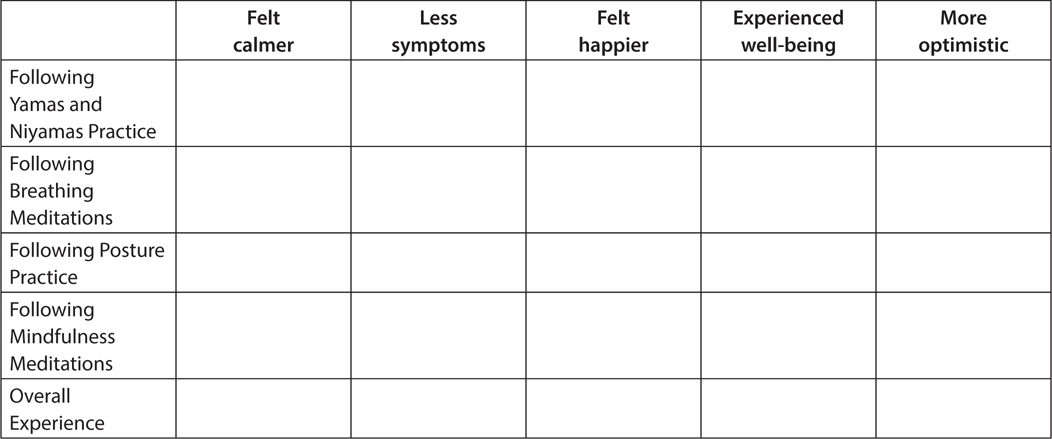
FIGURE 11.9 Chart Your Stress Reduction Experience